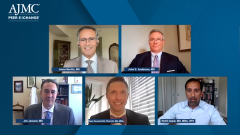
Cost of Care Driven by Early ACC Guideline-Directed Therapy in HF
Jaime Murillo, MD, shares insight on the significance of early use of American College of Cardiology treatment guidelines to manage total cost of care for patients with heart failure.
Episodes in this series

Ryan Haumschild, PharmD, MS, MBA: Dr Murillo, you talked about this earlier. How do we prevent progression? How do we get the right therapies on? Dr [Jim] Januzzi jumped in and said: “We have to get the right therapy onboard.” Instead of titrating 1 medication to its optimal dose, how do we make sure that we’re attacking heart failure from that quadruple aim? Maybe not starting all at once, but working toward that. Dr Murillo, how does the earlier guideline-directed medical management affect the total cost of care and patient outcomes? Because as we’re adding more therapies, the acquisition cost of the drug goes up a little, but we could potentially have outcomes reducing hospitalization and readmissions. How can payer organizations utilize programs or tools to promote early detection, identification, and management of that disease to slow the progression?
Jaime Murillo, MD: That’s a complex question and answer. The obvious part of this story is that the earlier you start guideline-directed medical management, the sooner you’re going to see results and the more likely it is that patients will avoid hospitalizations—either first-time hospitalizations or recurrent admissions—in addition to even prolonging survival in some cases. That leads to reduced cost of care. That’s an obvious sequence. The part that’s intricate here is something Dr Januzzi mentioned that is critical: How do we personalize medicine? That’s one area where we have a lot of opportunities, not today necessarily, but working forward.
In the R&D [research and development] environment where we do a lot of innovation, we’re working on several fronts. One of them is, can we utilize other data beyond the clinical part of the history to identify patients who are at risk of heart failure? To Dr [Rohit] Uppal’s comments, it isn’t just about handing [patients] the medication. It’s also taking a look at their SDOH [social determinants of health] and so on. How much can we learn about that person and their level of socioeconomic status, social determinants of health, their understanding of the disease, and support they have? Then go in and advance our digital signaling, whether they could be active or passive, whether we can have multiomics-related data, and so on. Ultimately, our goal will be to try to figure out who are the right patients for whom we can start the right medications earlier on so we can prevent admissions for heart failure. That’s one critical point.
The other opportunity is, how we can utilize the real-world evidence to try to figure out whether we’re doing a good job? Because unfortunately, for guidelines, we can count on only a certain number of RCTs [randomized controlled trials], and those RCTs may take 4 or 5 years, include 4,000 or 5,000 patients, and they’re mostly focused on 3 or 4 heart outcomes. We talked about how to maybe include some intermediate outcomes as part of the conversations we’ve had with the FDA as well. Then can we utilize existing data on millions of patients and see the current utilization of more novel therapies, like SGLT2s or ARNIs [angiotensin receptor-neprilysin inhibitors], and the populations that could benefit from them. Can that contribute to our knowledge and not make us wait until we have data in these guidelines in 4 or 5 years? That’s another opportunity where we can be more dynamic about all that we can do to overall prevent heart failure and reduce cost of care.
Ryan Haumschild, PharmD, MS, MBA: You made such a great point, because there are so many patient needs of subpopulations, and we can’t wait 6 years for a randomized clinical controlled trial to start to make decisions. How do we leverage some of this real-world evidence to think of unique patient populations to make sure they’re getting access to a therapy earlier on if it will provide the greatest benefit and need? That’s a great comment. I’m very hopeful that we can start to leverage those data to create more timely access across the board.
Transcript edited for clarity.
Newsletter
Stay ahead of policy, cost, and value—subscribe to AJMC for expert insights at the intersection of clinical care and health economics.




























































